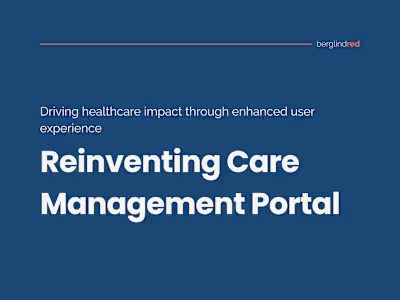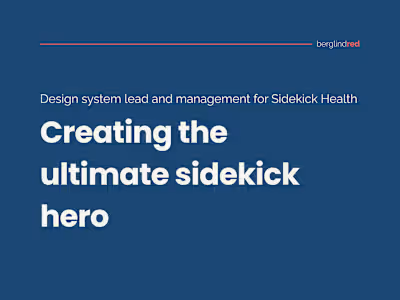Effortless Impact: UX Case Study on World-Changing Features
Article from medium
Apr 29, 2021
--
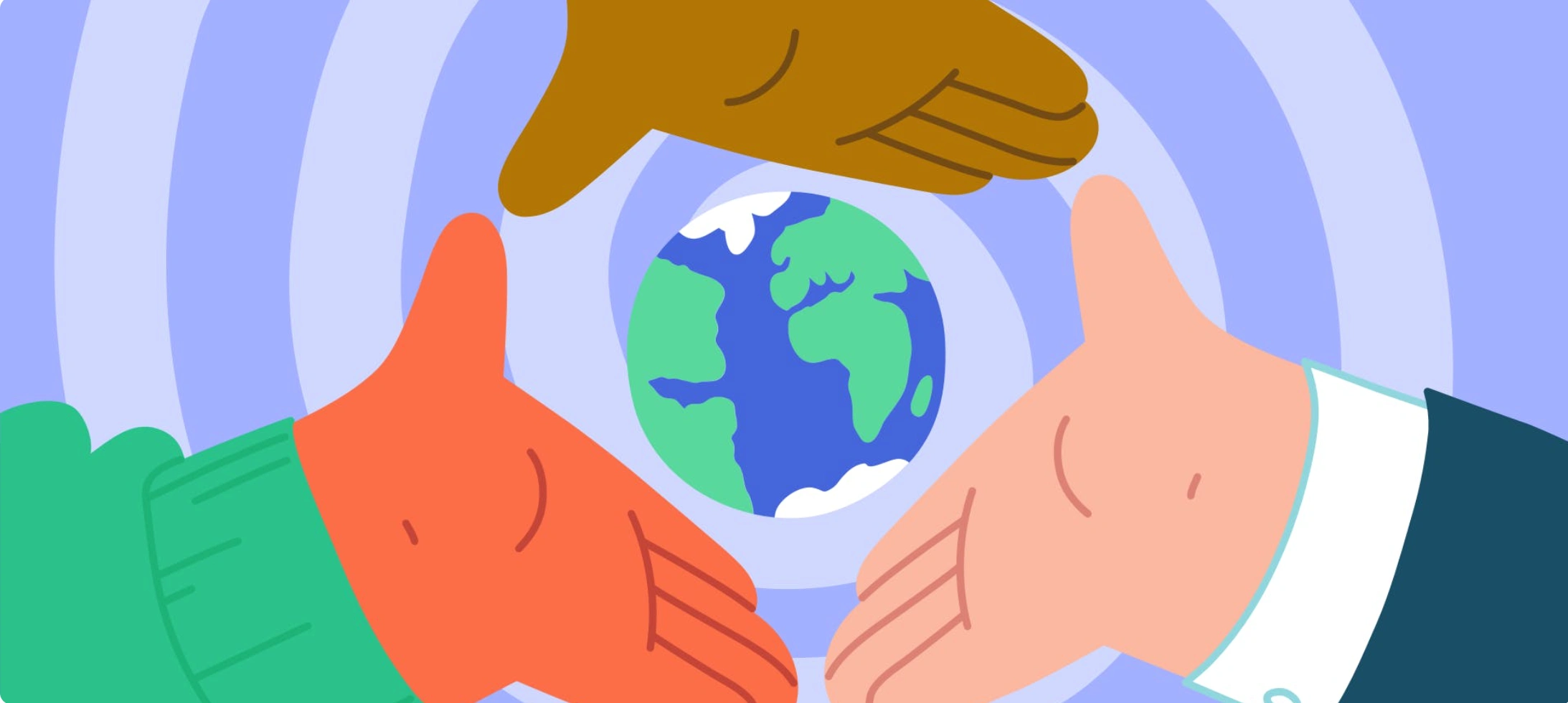
Hands by Ivan Mesaroš
TL;DR Create a “one-stop shop” for global issue topics that engage the users to make a positive impact, provides the user a transparent data-driven flow, and sends them meaningful feedback base on their contribution.
Hi! This article is a summary of my assignment for the four-week Field Work module as a part of the UX designer upskill diploma from Hyper Island.
In the module, we learn to do fieldwork to understand users’ wants and needs, how to gather data, select research methods, and conduct user interviews. In this article, I will be focusing on discovering and defining the problem I was facing and conduct unstructured research findings to gain insights, discover principles, and do a recommendation based on my findings.
1. Challenge 🧐
My challenge brief was “How might we create a feature that delivers effortless positive change to the world?”. The challenge was based on the persona named Raven, a 35-year-old female that wants to make a positive impact on many different pressing global issues that we face today ranging from injustice, poverty, climate issues, and sustainability. All while being up to date on Instagram and taking care of her social life.
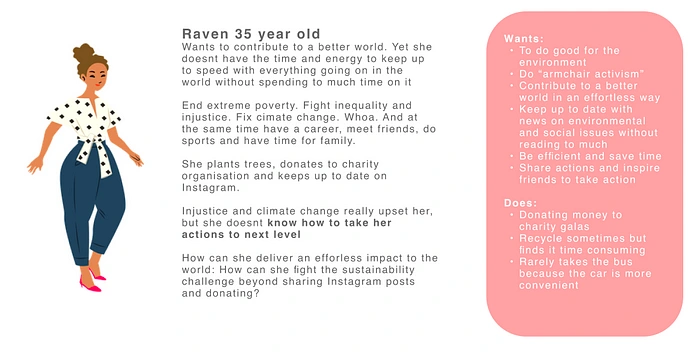
Raven, the challenge persona
Objective
The research objective is to discover the problem in the challenge and define the user's needs and wants. How can we make it easier for people to get educated about the problem and how can we help them make a positive impact?
In the attempt to construct and measure such a comprehensive topic I will focus on the term Global issues and that covers topics of
The topic of climate change and sustainability
The topic of injustice and inequality issues
The topic of humanitarian and developmental aid.
2. Fieldwork — Let’s kick it off 👩💻
I did a Challenge kick-off to help me identify the problem, target group, user needs, product, and business benefits. From that data, I was able to form hypotheses about user needs.
Target group
To identify our target group I looked at the market segment. Who is the product likely to benefit from? Who are its users and its customers? Looking at the challenge persona, I defined my target group by personal state and personal traits.

Target group
Users needs
With our target group defined I was able to start making assumptions about the user needs, their problems, and what obstacles they are trying to overcome. I defined the user's needs after motivating factors and what we know about the users.
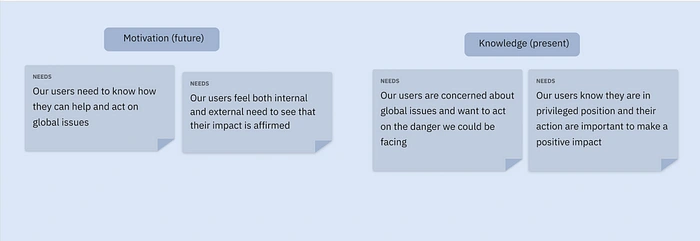
User needs
Product features
Now is time to look at the product and list what are the top features that are critical for the product's success. The top features are on one hand to help users explore, educate and understand global issues. And on the other hand to celebrate achievements by giving updates on their personal impact and give users positive reinforcement.

Product features
Business benefit
The motivation for the business behind this product is to use education to nudge users to make the user respond more often and use feedback to retain the users on the platform.

Business benefits
Problem statements
I used a problem statement or point of view (POV) statement, to frame the user's needs for the problem and create a testable hypothesis. With the four W’s in my mind (who is experiencing the problem, what is the problem, where does the problem present itself, and why does it matter) and I believes/assumptions about the target group and user needs I formed these four hypotheses:
1. We believe our users need to know how they can help and act on global issues
2. We believe our users know they are in a privileged position and their action are important to make an impact
3. We believe our users are concerned about global issues and want to act on the danger we could be facing
4. We believe … our users feel both internal and external need to see that their impact is affirmed
I then used the Prioritization Matrix to map out the known vs unknown needs and important vs less important needs. I felt that the first three hypotheses are quite known and important. But the fourth hypothesis is mostly unknown and therefore very interesting to gain more insights about that user need.
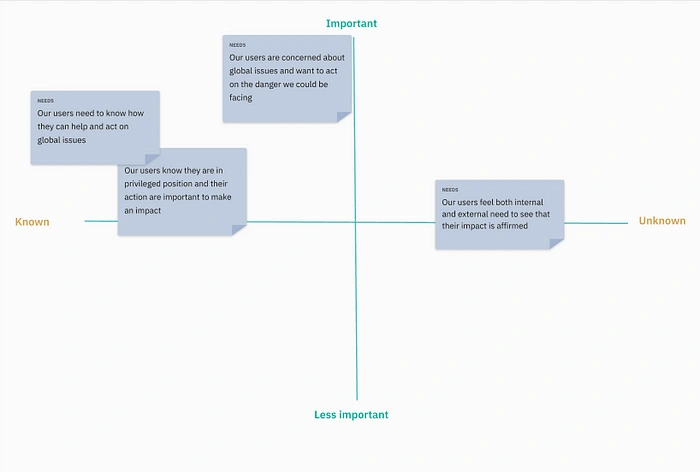
Prioritization Matrix
3. Research — let’s put on our lab coat 🥼
After generating my hypothesis I needed to validate my statements with research data. To gather research data about our target users, I followed the first diamond in the Double Diamond design process: Discover and define the right problem with both quantitative and qualitative research methods.
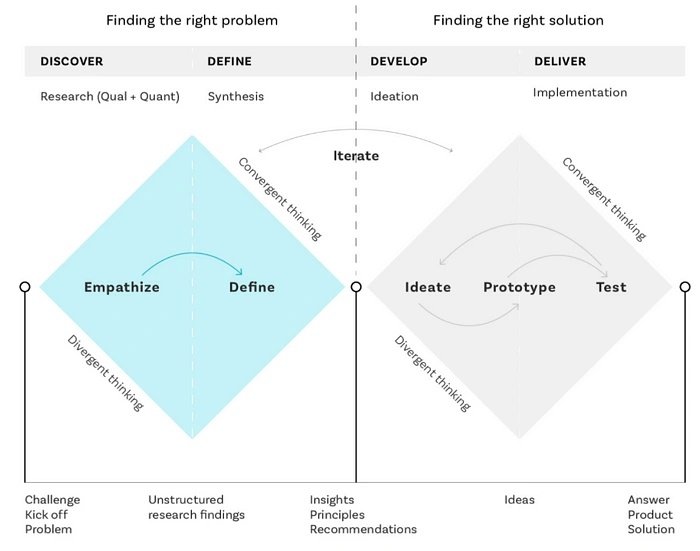
Double diamond design process. Adapted from Dan Nessler
Quantitative research
To get my quantitative data I created an online survey via Google Forms and sent it out to a group network that I knew included many individuals that would fit my defined target group.
I received a total of 23 responses to my survey. Looking at the demography I noticed that:
78.3% were aged 30 to 40 years old.
60.9% were female and 39.1% male.
78.2% had a BSc degree or higher
52.2% were married or in a long term relationship with child or children and 30.4% married or a long term relationship
Looking into personal attitudes to making an impact on global issues, most users agreed that their actions make a difference, they have the right resources to make an impact, they feel both internal and external need to act on global issues and they want to be seen as a sympathetic person. Most users were neutral when asked if it is easy to find information on global issues and when they were asked if they felt the need to receive affirmation when they make an impact on global issues.
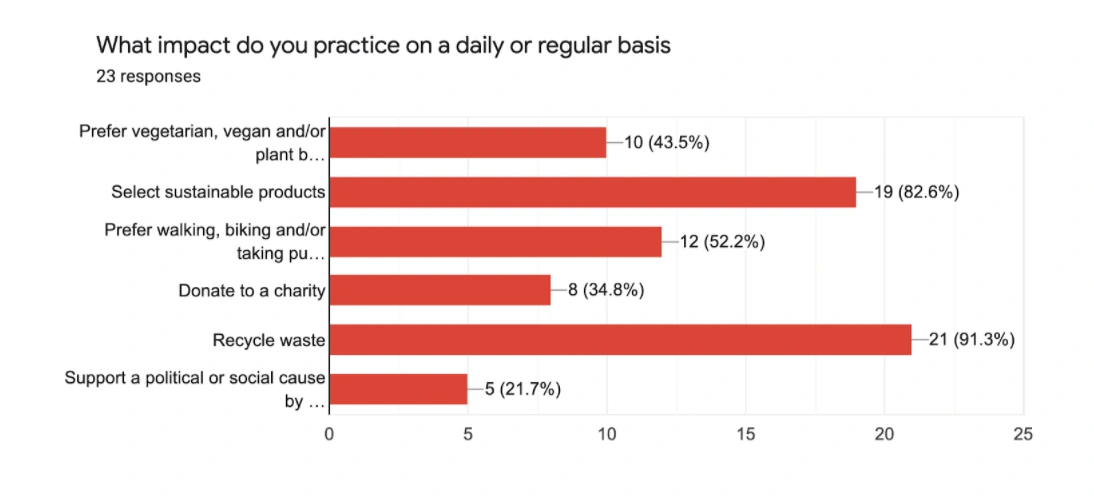

When looking at the personal attitudes after global issue topics, most users agreed or strongly agreed that they found it to be important for humanity to act on all three global topics and most of them agreed they had sympathy regards all three global issue topics. A higher percentage of the users agreed that they are knowledgeable about climate and sustainability and fewer said they are knowledgeable about the other two global topics. Most users either disagreed or were neutral when asked if they felt it was easy to make an impact over time on all three global issue topics.

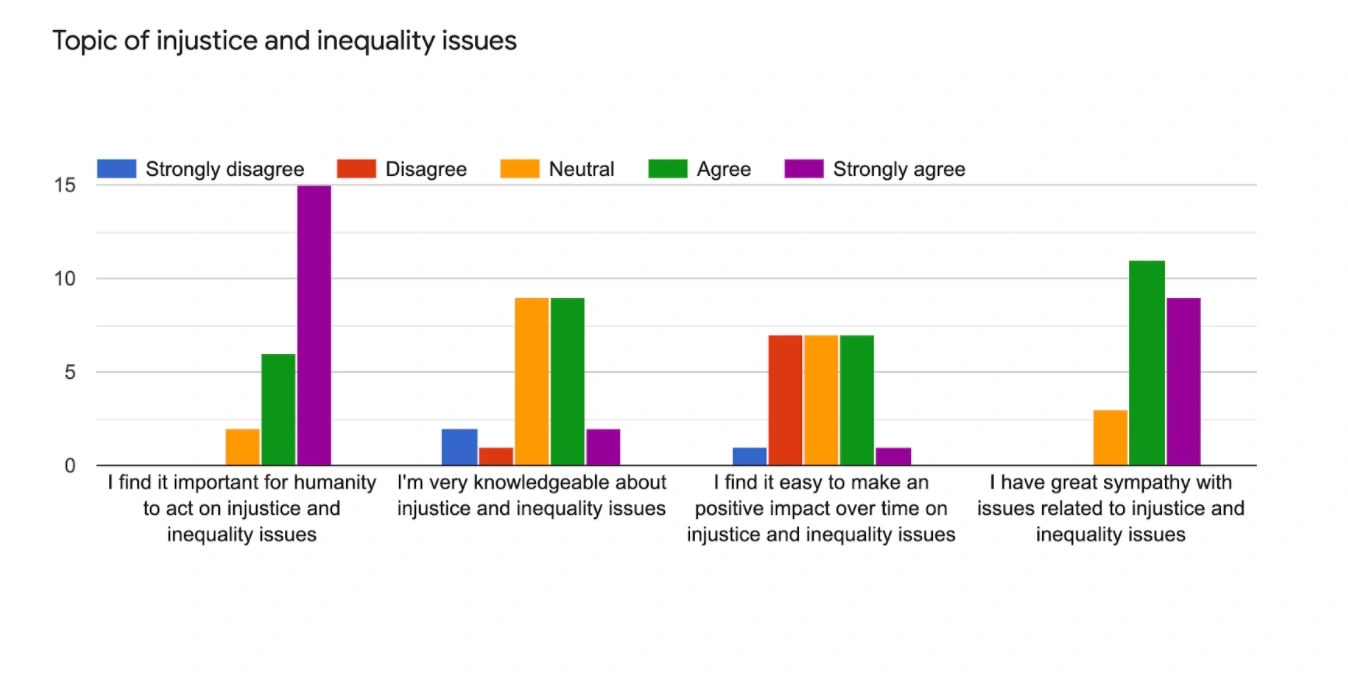
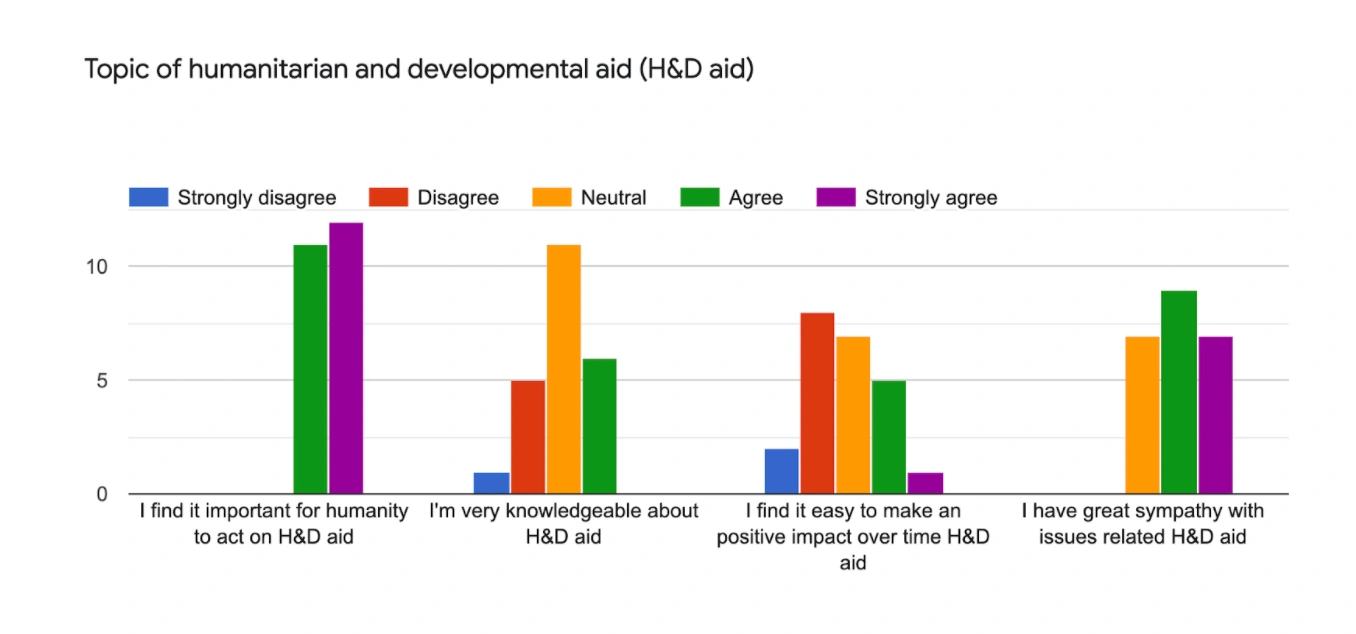
Qualitative research
To get a deeper understanding of the problem and user needs, I did 1:1 semi-structured interviews with four participants. Before setting the interviews up I wrote a Discussion guide with a set of questions and topics that I wanted to walk the research participants through to reach my learning objectives.
At the beginning of the interview, I introduced myself and the project and asked for permission to take notes and make a video record of the interview. I also made sure to let the participants know that we wanted to get the participant's thoughts and feelings, that there are no right or wrong answers and I asked them to speak their full honest opinion. I then did a little warm-up session with the participants, asking them about their background and their relationship with global issues.
Next up was the in-depth interview. The idea was to keep all my questions open-ended allowing for a discussion with the participant rather than a straightforward question and answer format. I then asked follow-up questions to get a deeper understanding of the topic.
After each interview, I did a summary and wrote down comments that I felt stood out of the interview. Lastly, I used a transcribing tool to help me transcribe the interviews.

Participants profiles
4. Synthesis — Where it all makes sense 💡
Synthesis in UX design thinking is a method to make sense of the data collected during user research. It helps us create a model of the user's reality so we can gain a better understanding of the problem and user needs. From there we can generate principles and test our hypothesis.
Insights statements
I used affinity mapping to help me gather my thoughts on sticky notes, cluster similar thoughts, and uncover patterns in thoughts and behavior from the qualitative interviews.

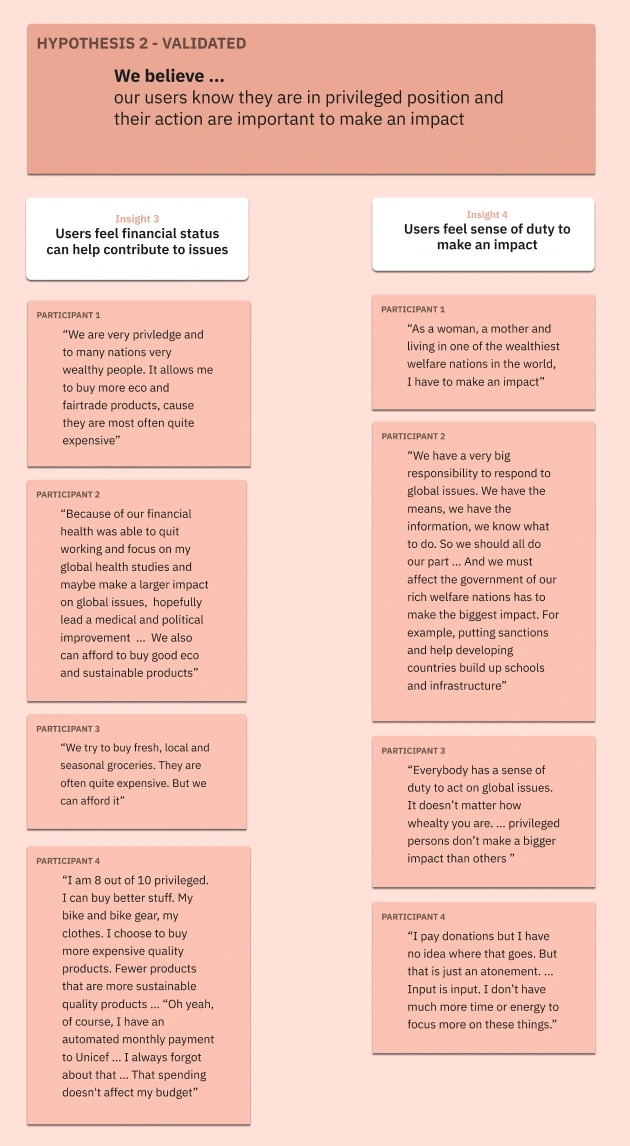
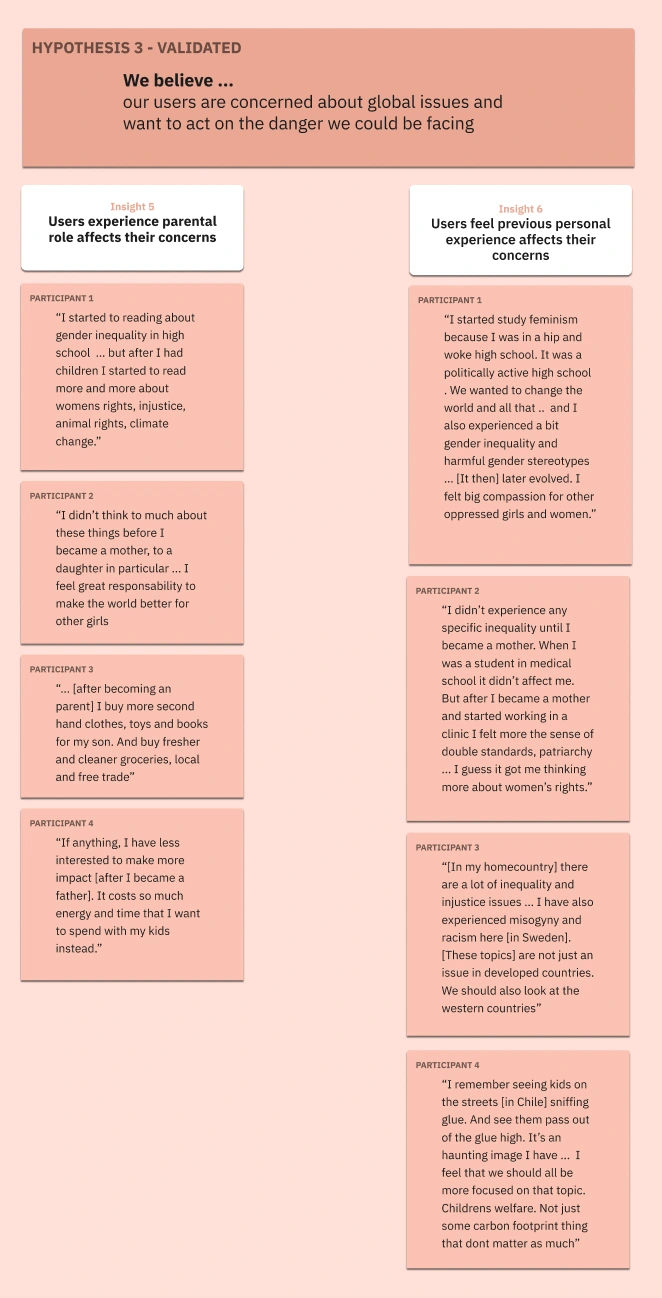
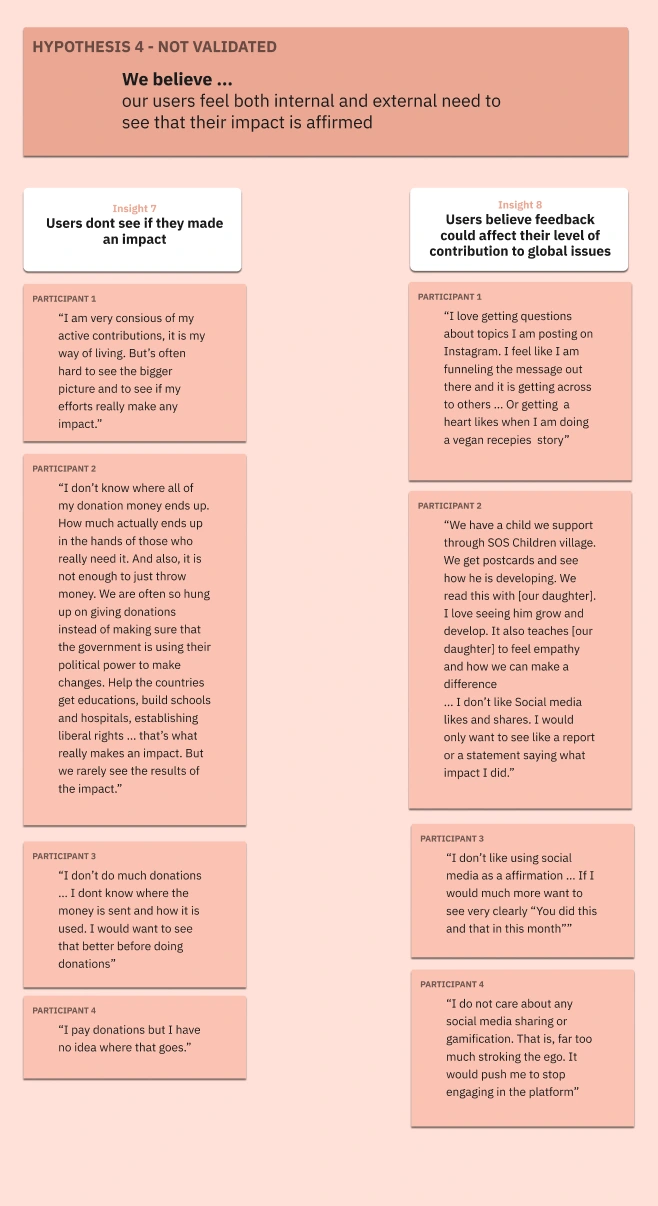
Looking at the results from the Affinity mapping, I was able to group eight insight statements that I gathered from the interviews.
Insight 1 User experience information overload
Insight 2 Users feels the topics are are all connected
Insight 3 Users feel financial status can help contribute to issues
Insight 4 Users feel sense of duty to make an impact
Insight 5 Users experience parental role affects their concerns
Insight 6 Users feel previous personal experience affects their concerns
Insight 7 Users dont see if they made an impact
Insight 8 Users believe feedback could affect their level of contribution to global issues
Hypothesis
My first three hypotheses were validated after the qualitative interviews. Looking at the interview findings we can see that most of the users wanted to contribute and make an impact on all global issue topics but they experienced an overwhelming amount of information, different channels, different aspects, actions, and so forth. They also experienced that all of the issue topics were connected but they had different ideas of causation and correlations. These findings validate the first hypothesis “We believe our users need to know how they can help and act on global issues”.
The second hypothesis “We believe our users know they are in a privileged position and their contributions are important to make an impact” was also validated. It was quite apparent that all of the interviewees knew they lived in one of the richest countries in the world, they experienced welfare, safety, liberty, and good financial health. In other words, they believed they were lived very privileged lives compared to most others in the world. They also knew that their privileged status comes with personal responsibility to make an impact on global issue topics. All users felt that their financial health made it easier for them to create either a lifestyle or a quality of life that also contributes to global issues. F.ex buying sustainable quality fashion clothing or buying fresh, eco, and local groceries.
The third hypothesis “We believe our users are concerned about global issues and want to act on the danger we could be facing” was also validated. All interviewees had children and expressed that the parental role affected their concerns for global issue topics. Most of them expressed that they felt the need and responsibility to make an impact on global issues to create a better world for their children and other children in the world that are suffering from global issue topics. On the other hand, the male interviewee expressed that becoming a father made him contribute less on global issue topics and instead had him focus on his children's welfare. Personal experience also affected their concerns for global issue topics. The email interviewees expressed that they had experienced gender-related experiences in the past and that affected their concerns for equality and injustice.
But my fourth hypothesis, “We believe … our users feel both internal and external need to see that their impact is affirmed”, was not validated. I had anticipated that the users would experience more need to get humble bragging rights on social media and collect f.ex likes on Facebook posts or hearts on Instagram from friends and peers. I had also anticipated that they wanted to receive a badge or a personal compliment from global issue organizations. But most users said they would not care to get any compliment at all. They rather wanted to see the output from their input and affirmation that their contribution made a difference.
Principles
I then used the insight statements to help me frame my “How Might We…” (HMW) questions and create solution-centered ideas for our user's needs and hypotheses. From the principles, I added my recommendation for the next step.

Principle statements and next steps from Insights and Hypothesis
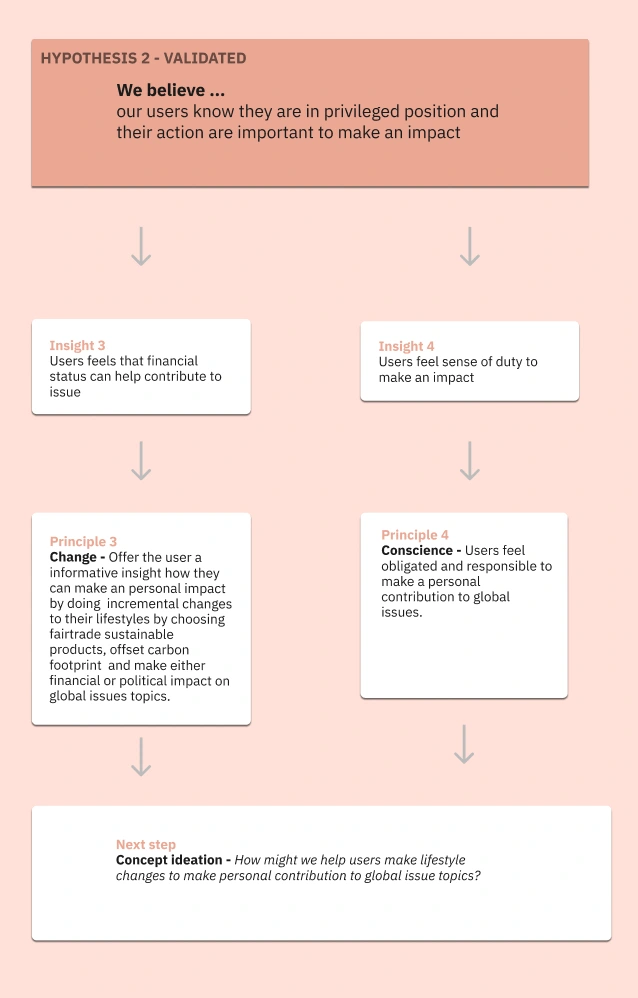
Principle statements and next steps from Insights and Hypothesis
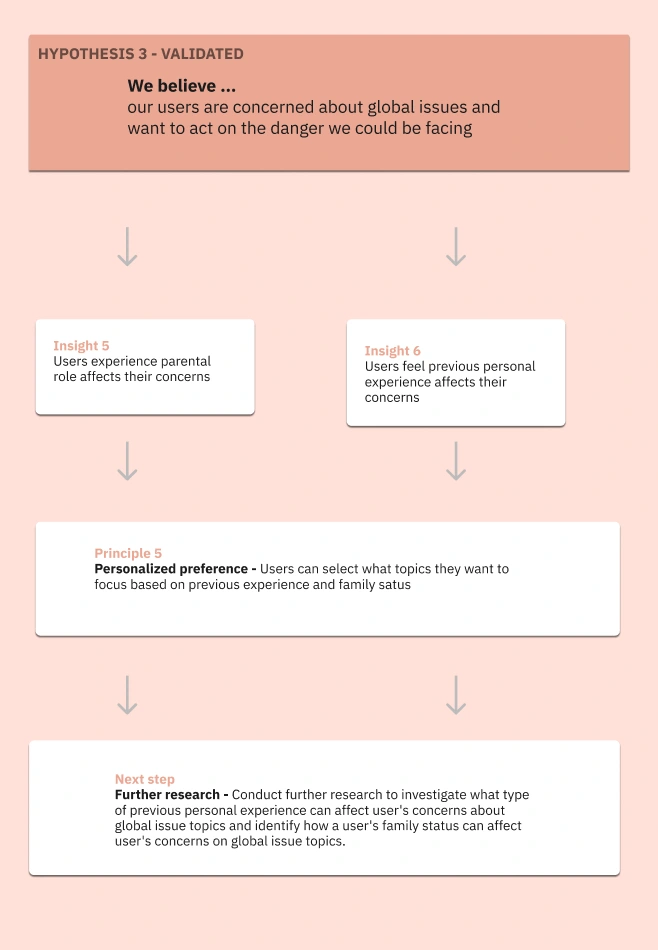
Principle statements and next steps from Insights and Hypothesis
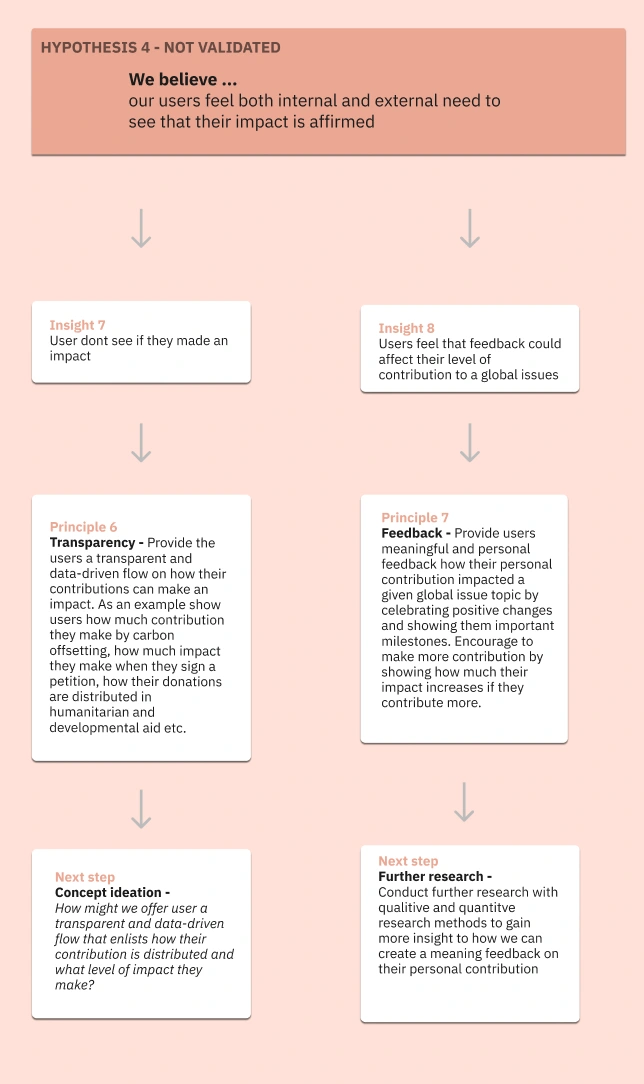
Principle statements and next steps from Insights and Hypothesis
Out of the eight insight statements I was able to create seven Principles and from there six next step recommendations. The principles are
Principle 1 Integration — Users feel overwhelmed by an abundance of information and actions distributed they find in many different channels and organizations. We want to scrape together most global-related organizations to give the users a “one-stop quick shop” platform for all global issues topics. The platform includes accessible information about global issue topic and a feature to execute a quick action impact
Principle 2 Causation — Provide users insight into how their impact on one topic can have a positive impact on another global issue topic, encouraging the user to plant a “tree of impact” and see that tree grow to a forest
Principle 3 Change — Offer the user an informative insight into how they can make a personal impact by doing incremental changes to their lifestyles by choosing fairtrade sustainable products, offset carbon footprint and make either financial or political impact on global issues topics.
Principle 4 Conscience — Users feel obligated and responsible to make a personal contribution to global issues.
Principle 5 Personalized preference — Users can select what topics they want to focus on based on previous experience and family status
Principle 6 Transparency — Provide the users a transparent and data-driven flow on how their contributions can make an impact. As an example show users how much contribution they make by carbon offsetting, how much impact they make when they sign a petition, how their donations are distributed in humanitarian and developmental aid etc.
Principle 7 Feedback — Provide users meaningful and personal feedback on how their personal contribution impacted a given global issue topic by celebrating positive changes and showing them important milestones. Encourage to make more contribution by showing how much their impact increases if they contribute more.
Prioritizing matrix for next steps
The Principle Statements and Next step recommendation almost created more user problems and research questions rather than answering the initial challenge problem “How might we create a feature that delivers effortless positive change to the world?” For further investigation, I suggest researching principle 1 so we can develop a “one-stop quick shop” global issue platform. I think this feature will solve most of the user's pain points. It will provide a high user value but will most likely also cost high effort by the organization. For principle 5 we need to identify what type of personal experience affect users concern on a global issue and identify how family status can affect users concerns on a global issue. This requires quite a low effort of the organization but above medium user value. For principle 7 we need more insight on what kind of feedback the users want to get for their personal contribution. This feature is also a top feature with principle 1, it has a high user value but requires lower efforts from the organization. We should also investigate how we can use that feedback to increase user retention, make users contribute more on the same topics, and nudge users to make contributions to other global issue topics that can relate to principle 2 on how we can create causation between making an impact on the global issue topics.
For concept ideation, the next step for principle 6 is one of the highest efforts by the organization and user value. It might take quite some ideation and investigation to identify what the user wants to see in the flow, what data we can scrape, and how we can create a transparent data-driven flow. That feature could also be aligned with the next step for principle 2 on how we can create causation between making an impact on the global issue topics. The next step for principles 3 and 4 might is ranked lowest on the User Value but it might also require quite low efforts by the organization.
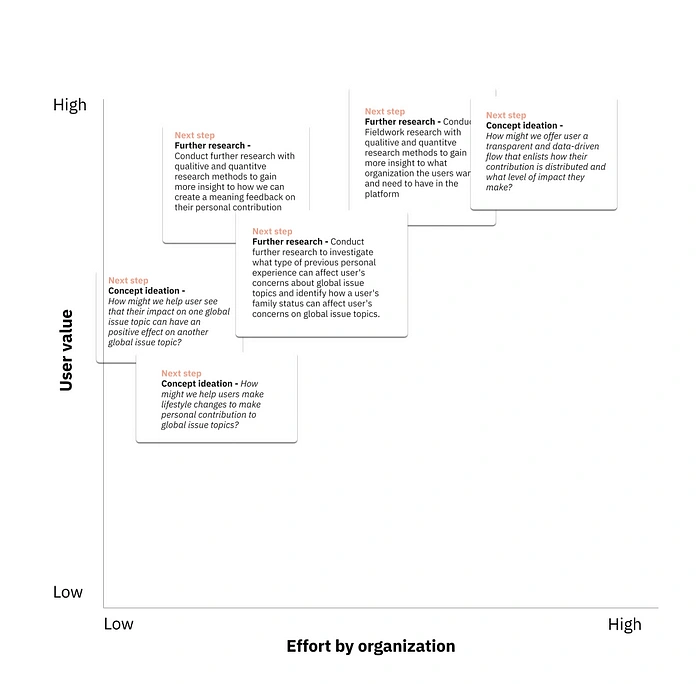
Prioritizing matrix
It was also interesting to find that both survey participants and the interviewees were most concerned about humanitarian and developmental aid, but their lifestyle and contributions impacted mostly only climate change and sustainability. This insight is another opportunity for further investigation. “How might we create a feature that helps users to make bigger impact on humanitarian and developmental aid?”
5. Reflections — the good, the bad, and the ugly✨
Oh boy, how much I learned from this assignment. I’ve done user surveys and interviews before, both in previous studies and in my work. A couple of questions here, some assumptions from there, a summary about the user’s wants, needs, and experience, and BOOM you are done. So this should be quick and easy, right?
You guessed it, it was neither quick nor easy. In my previous experience, I had never conducted this user research fieldwork so much “by the book”. From studying the challenge brief to understand the user needs and wants to conduct surveys and user interviews to summarize and conceptualize the findings.
Although I am quite confident and content about my insights and findings, I feel that my research had many limitations and that affected my results and recommendations. The main limitations are that I had a relatively small research sample, all the participants were all quite homogeneous, I built my hypothesis quite blindly on my own pre assumptions, I could have dug even deeper into the user interviews and gain even more insights from them and I feel I was too quick to assume that our only solution would be within a digital platform (app or website). These are all new learnings that I will take into account in my next UX research project.
Like this project
Posted Apr 30, 2024
TL;DR: Develop a unified platform for global issues, engaging users in impactful actions with transparent, data-driven feedback on their contributions.
Likes
0
Views
1
Clients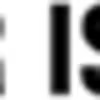

Hyper Island





